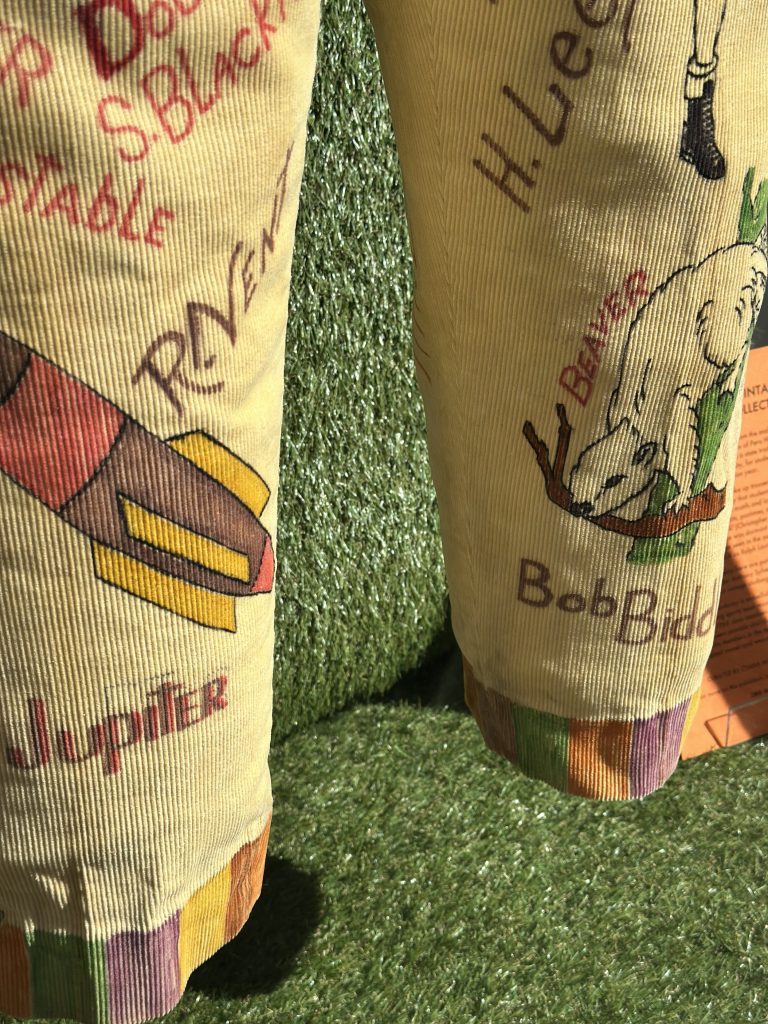Covet: Vintage & the Collector
Exhibition 6: COVET: VINTAGE & THE COLLECTOR
Curators: Cyana Madsen and Anthony Sylvester
Date: 28th March – 6th April 2025
Central to anthropologist Igor Kopytoff’s paper The Social Life Of Things (1986) is the idea that every object has a life cycle; moving through different social and cultural contexts, gaining new meanings and values as it is used, traded, passed on, forgotten and discarded. While every object is initially created for a specific function, as it interacts with the world, it develops its own narrative, its own biography.
Tangible examples of this biography can be found in collections of vintage clothing. A garment created for a specific purpose may outlive its original utility and find new life in a new environment, under new circumstances. For example, attire designed to be worn by military personnel might be marketed for sale as ‘surplus’ to be bought and worn by civilian owners far removed from its martial origins.
These trousers originate from the mid 1960s and were made specifically for an alumnus of Peru High School in Indiana, United States of America. It was a state tradition, originating back in 1904 at Perdue University, for students to don ‘senior cords’ to celebrate their graduation year. Local tailors would make up trousers or skirts of pale yellow or cream cotton corduroy that students would then embellish with drawings of personal motifs and iconography of their favourite subjects, pastimes, and passions: creating a ‘wearable yearbook’ (Christopher Bernard, New York Times, 2023). The practice was dormant by the end of the 1970s, though its influence can be seen in the output of contemporary American design houses such as Ralph Lauren and Bode.
Despite the hyper-localised (both in geographical and temporal terms) nature of the senior cord tradition, vintage clothing enthusiasts obsess over and trade rare examples as they appear on the market, creating a new audience for the trousers far away from the American Midwest and from the trousers’ original intention and meaning.
The pair on display here are part of the archive collection of studio co-founder Anthony Sylvester and were bought from an East London vintage clothing dealer in 2019. The beige corduroy is embellished with hand drawn marker pen depicting sports team mascots, scholastic topics, and the names of 1966 class members and teammates. The illustrations on these trousers provide vital clues in identifying the fellow students and faculty members in the text and images, though the name of the original owner and wearer is lost to time.
“The appeal of the ‘Senior cords’ for a clothing collector such as myself is manifold. They represent a great example of classic ‘Ivy League’ Americana that is high on my personal list of items I like to collect. Secondly, they are explicitly linked to the original owner’s biography in a way that is actually tangible and researchable. Corduroy is also a very appealing cloth to me, but most of all, they are entirely unique – there is no other identical pair in existence. If I had passed up the opportunity to pick these up when I did, I doubt another similar pair would ever have crossed my path.” (Anthony Sylvester, 2025)
These senior cord trousers are symbolic not only of the memories of the person who originally modified and wore them but have become recontextualised and are now the coveted possession of a contemporary collector.
Images Courtesy of Madsen Sylvester Studio.

